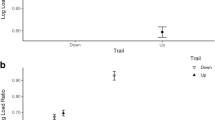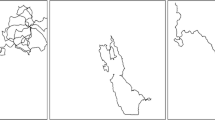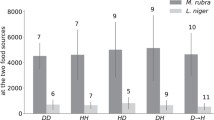Abstract
The stochasticity in food quality and availability, and physical trail characteristics experienced by leaf-cutter ants, may favour individual flexibility in load-mass selection so as to forage effectively. The present study aimed to confirm previous evidence, from Atta cephaoltes foragers, of variable load-mass selection in response to steep inclines and declines in the leaf-cutter ant Acromyrmex octospinosus. The foraging trail gradient of a captive colony of Ac. octospinosus was manipulated by altering the position of a foraging platform relative to the nest box. The results indicate an effect of steep gradients on walking speed and variation in load mass in relation to gradient as a result of individual plasticity, not recruitment of different-sized individuals. Ants selected heavier loads when returning to the nest vertically downwards than when returning horizontally or vertically upwards. These results are discussed with reference to foraging performance. Walking speed was considerably reduced on upward returns to the nest, but was also slower when travelling vertically downwards compared with horizontal trails, suggesting vertical trails per se impact on the time costs of foraging. Differences in load-mass selection were evident from the onset of foraging and did not change significantly over the course of 24 h, suggesting this behaviour was based on individual experience, rather than colony-level information feedback. The present study has demonstrated that Ac. octospinosus foragers are capable of individual flexibility in load-mass selection in response to a physical trail characteristic that is pertinent to their natural habitat and is a factor seldom considered in theoretical foraging models.




Similar content being viewed by others
References
Belovsky GE (1978) Diet optimization in a generalist herbivore: the moose. Theor Pop Biol 14:105–134
Bernadou A, Espadaler X, Dos-Reis V, Fourcassié V (2011) Effect of substrate roughness on load selection in the seed-harvester ant Messor barbarous L. (Hymenoptera, Formicidae). Behav Ecol Sociobiol 65:1763–1771
Bonser R, Wright PJ, Bament S, Chukwu UO (1998) Optimal patch use by foraging workers of Lasius fuliginosus, L. niger and Myrmica ruginodis. Ecol Entomol 23:15–21
Burd M (1995) Variable load size-ant size matching in leaf-cutting ants, Atta colombica. J Insect Behav 8:715–722
Burd M (1996) Foraging performance by Atta colombica, a leaf-cutting ant. Am Nat 148:597–612
Burd M (2000) Body size effects on locomotion and load carriage in the highly polymorphic leaf-cutting ants Atta colombica and Atta cephalotes. Behav Ecol 11:125–131
Burnham KP, Anderson DR (2002) Model selection and multimodel inference: a practical information-theoretic approach. Springer
Charnov EL (1976) Optimal foraging, the marginal value theorem. Theor Pop Biol 9:129–136
Cherrett JM (1972) Some factors involved in the selection of vegetable substrate by Atta cephalotes (L.) (Hymenoptera: Formicidae) in tropical rain forest. J Anim Ecol 41:647–660
Dornhaus A, Franks NR (2008) Individual and collective cognition in ants and other insects (Hymenoptera: Formicidae). Myrmecol News 11:215–226
Dussutour A, Beshers S, Deneubourg J-L, Fourcassié V (2007) Crowding increases foraging efficiency in the leaf-cutting ant Atta colombica. Insect Soc 54:158–165
Dussutour A, Deneubourg J-L, Beshers S, Fourcassié V (2009) Individual and collective problem-solving in a foraging context in the leaf-cutting ant Atta colombica. Anim Cogn 12:21–30
Farji-Brener AG, Barrantes G, Laverde O, Fierro-Calderón K, Bascopé F, López A (2007) Fallen branches as part of leaf-cutting ant trails: their role in resource discovery and leaf transport rates in Atta cephalotes. Biotropica 39:211–215
Farji-Brener AG, Amador-Vargas S, Chinchilla F, Escobar S, Cabrera S, Herrera MI, Sandoval C (2010) Information transfer in head-on encounters between leaf-cutting ant workers: food, trail condition or orientation cues? Anim Behav 79:343–349
Farji-Brener AG, Chinchilla F, Rifkin S, Sánchez Cuervo AM, Triana E, Quiroga V, Giraldo P (2011) The ‘truck-driver’ effect in leaf-cutting ants: how individual load influences the walking speed of nest-mates. Physiol Enomol 36:128–134
Full RJ, Tullis A (1990) Energetics of ascent: insects on inclines. J Exp Biol 149:307–317
Hölldobler B, Wilson EO (1990) The ants. Springer Verlag
Holt NC, Askew GN (2012) Locomotion on a slope in leaf-cutter ants: metabolic energy use, behavioural adaptations and the implications for route selection on hilly terrain. J Exp Biol 215:2545–2550
Howard JJ, Henneman ML, Cronin G, Fox JA, Hormiga G (1996) Conditioning of scouts and recruits during foraging by a leaf-cutting ant, Atta colombica. Anim Behav 52:299–306
Kacelnik A (1984) Central place foraging in starlings (Sturnus vulgaris). I. Patch residence time. J Anim Ecol 53:283–299
Kacelnik A (1993) Leaf-cutting ants tease optimal foraging theorists. TREE 8:346–348
Lewis T, Pollard GV, Dibley GC (1974) Rhythmic foraging in the leaf-cutting ant Atta cephalotes (L.) (Formicidae: Attini). J Anim Ecol 43:129–141
Lewis OT, Martin M, Czaczkes TJ (2008) Effects of trail gradient on leaf tissue transport and load size selection in leaf-cutter ants. Behav Ecol 19:805–809
Lighton JRB, Bartholomew GA, Feener DH Jr (1987) Energetics of locomotion and load carriage and a model of the energy cost of foraging in the leaf-cutting ant Atta colombica. Physiol Zool 60:524–537
Lighton JRB, Weier JA, Feener DH Jr (1993) The energetics of locomotion and load carriage in the desert harvester ant Pogonomyrmex rugosus. J Exp Biol 181:49–61
Lipp A, Wolf H, Lehmann F-O (2005) Walking on inclines: energetics of locomotion in the ant Camponotus. J Exp Biol 208:707–719
Lopes JFS, Forti LC, Camargo RS (2004) The influence of the scout upon the decision-making process of recruited workers in three Acromyrmex species (Formicidae: Attini). Behav Process 67:471–476
Lutz F (1929) Observations on leaf cutting ants. Am Mus Novit 388:1–21
Moll K, Roces F, Federle W (2010) Foraging grass-cutting ants (Atta vollenweideri) maintain stability by balancing their loads with controlled head movements. J Comp Physiol A 196:471–480
Moll K, Roces F, Federle W (2013) How load-carrying ants avoid falling over: mechanical stability during foraging in Atta vollenweideri grass-cutting ants. PLoS ONE 8:e52816
Morehead SA, Feener DH Jr (1998) Foraging behaviour and morphology: seed selection in the harvester ant genus, Pogonomyrmex. Oecologia 114:548–555
Nielsen MG (2001) Energetic cost of foraging in the ant Rhytidoponera aurata in tropical Australia. Physiol Entomol 26:248–253
Nielsen MG, Jensen TF, Holm-Jensen I (1982) Effect of load carriage on the respiratory metabolism of running worker ants of Camponotus herculeanus (Formicidae). Oikos 39:137–142
Orians GH, Pearson NE (1979) On the theory of central place foraging. In: Horn DJ, Mitchell RD, Stairs GR (eds) Analysis of ecological systems. Ohio University Press, Ohio, pp 154–177
Pyke GH (1984) Optimal foraging theory: a critical review. Ann Rev Ecol Syst 15:523–575
Roces F (1990) Leaf-cutting ants cut fragment sizes in relation to the distance from the nest. Anim Behav 40:1181–1183
Roces F (1993) Both evaluation of resource quality and speed of recruited leaf-cutting ants (Acromyrmex lundi) depend on their motivational state. Behav Ecol Sociobiol 33:183–189
Roces F, Hölldobler B (1994) Leaf density and a trade-off between load-size selection and recruitment behavior in the ant Atta cephalotes. Oecologia 97:1–8
Roces F, Núñez JA (1993) Information about food quality influences load-size selection in recruited leaf-cutting ants. Anim Behav 45:135–143
Roschard J, Roces F (2002) The effect of load length, width and mass on transport rate in the grass-cutting ant Atta vollenweideri. Oecologia 131:319–324
Rudolph SG, Loudon C (1986) Load size selection by foraging leaf-cutter ants (Atta cephalotes). Ecol Entomol 11:401–410
Schmid-Hempel P, Kacelnik A, Houston AI (1985) Honeybees maximize efficiency by not filling their crop. Behav Ecol Sociobiol 17:61–66
Schoener TW (1971) Theory of feeding strategies. Ann Rev Ecol Syst 2:369–404
Schoener TW (1979) Generality of the size–distance relation in models of optimal feeding. Am Nat 114:902–914
Seidl T, Wehner R (2008) Walking on inclines: how do desert ants monitor slope and step length. Front. Zool. 5. Available online at: http://www.frontiersinzoology.com/content/5/1/8
Shutler D, Mullie A (1991) Size-related foraging behaviour of the leaf-cutting ant Atta colombica. Can J Zool 69:1530–1533
Taylor CR, Caldwell SL, Rowntree VJ (1972) Running up and down hills: some consequences of size. Science 178(4065):1096–1097
Torres-Contreras H, Vasquez RA (2004) A field experiment on the influence of load transportation and patch distance on the locomotion velocity of Dorymyrmex goetschi (Hymenoptera, Formicidae). Insect Soc 51:265–270
van Breda JM, Stradling DJ (1994) Mechanisms affecting load size determination in Atta cephalotes L. (Hymenoptera, Formicidae). Insect Soc 41:423–435
Waller D (1989) Size-related foraging in the leaf-cutting ant Atta texana (Buckley) (Formicidae: Attini). Funct Ecol 3:461–468
Weier JA, Feener DH (1995) Foraging in the seed-harvester ant genus Pogonomyrmex: are energy costs important? Behav Ecol Sociobiol 36:291–300
Weihmann T, Blickham R (2009) Comparing inclined locomotion in a ground-living and a climbing ant species: sagittal plane kinematics. J Comp Physiol 195:1011–1020
Wetterer JK (1990) Load-size determination in the leaf-cutting ant, Atta cephalotes. Behav Ecol 1:95–101
Wetterer JK (1991a) Source distance has no effect on load size in the leaf-cutting ant, Atta cephalotes. Psyche 98:355–359
Wetterer JK (1991b) Foraging ecology of the leaf-cutting ant, Acromyrmex octospinosus, in a Costa Rican rain forest. Psyche 98:361–371
Wetterer JK (1993) Foraging and nesting ecology of a Costa Rican leaf-cutting ant, Acromyrmex volcanus. Psyche 100:65–76
Wetterer JK (1994) Forager polymorphism, size-matching, and load delivery in the leaf-cutting ant, Atta cephalotes. Ecol Entomol 19:57–64
Wetterer JK (1995) Forager size and ecology of Acromyrmex coronatus and other leaf-cutting ants in Costa Rica. Oecologia 104:409–415
Zollikofer CPE (1994) Stepping patterns in ants III. Influence of load. J Exp Biol 192:119–127
Acknowledgements
We are grateful to Dr Owen Lewis, University of Oxford, for providing information on his earlier research. Fraser Combe and Andrew Barr provided help with equipment and access to the laboratories at MMU, and provided background information on the ant colony used. Thanks are also due to Dr Martin Jones, MMU, for his help and advice regarding the revised manuscript. Finally, we would like to thank Dr Elizabeth Jones for her valuable comments on an earlier draft.
Author information
Authors and Affiliations
Corresponding author
Rights and permissions
About this article
Cite this article
Norton, V., Stevens-Wood, B. & Harris, W.E. Flexibility of Individual Load-mass Selection in Relation to Foraging Trail Gradient in the Leaf-cutter Ant Acromyrmex octospinosus . J Insect Behav 27, 370–384 (2014). https://doi.org/10.1007/s10905-013-9435-z
Revised:
Accepted:
Published:
Issue Date:
DOI: https://doi.org/10.1007/s10905-013-9435-z




